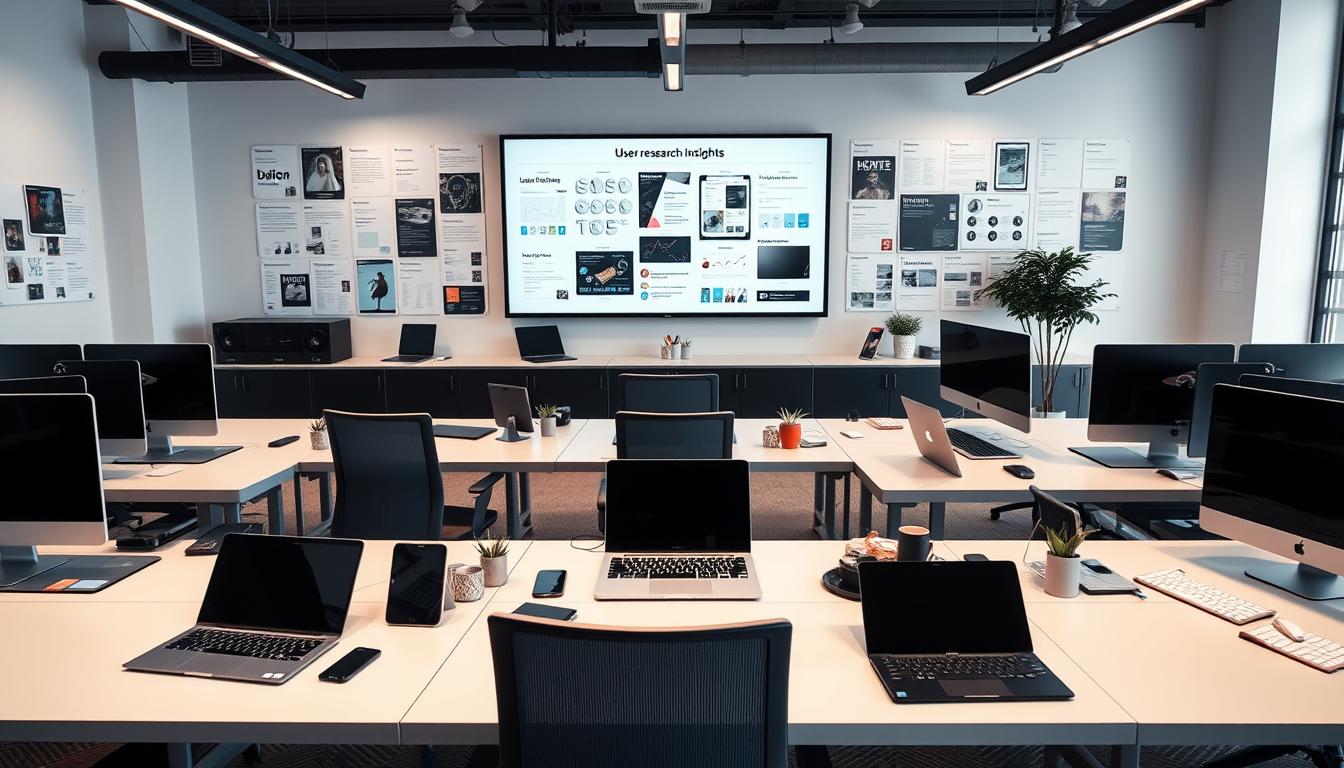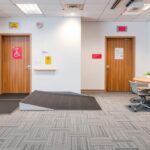“The only way to do great work is to love what you do.” – Steve Jobs
User testing is key in today’s digital world. It helps make digital products better and keeps users happy. Companies like Adam Fard Studio, Nielsen Norman Group, and Momentum Labs lead in this field. They offer many services, from specific industry tests to full user testing solutions.
These services are for all kinds of projects, from small startups to big companies. They work in many fields, like FinTech, SaaS, and healthcare. Their work shapes how we interact with digital products, making them better for users.
Prices for these services vary, from $49 to $300 an hour. This range helps meet the needs of different clients. It ensures users have a smooth and enjoyable digital experience.
Key Takeaways
- Top user testing companies like Adam Fard Studio, Nielsen Norman Group, and Momentum Labs offer a range of specialized services to refine digital products.
- These firms cater to various industries, including FinTech, SaaS, and healthcare, and their expertise contributes to the development of user-focused digital experiences.
- Pricing models for user testing services vary, with hourly rates ranging from $49 to $300, providing flexibility for startups, enterprises, and diverse client needs.
- Comprehensive user testing solutions from these companies play a crucial role in shaping the future of digital user interactions.
- The user-centric approach and innovative methodologies of these leading firms help ensure the success and satisfaction of digital product users.
Understanding User Testing and Its Importance
User testing is key in making products better. It uses real users to check how well a product works and if people like it. This helps improve the user experience, boost sales, and save money.
By watching how users interact with a product, companies can focus on what matters most. They learn what users want and don’t like. This way, they make products that meet real needs.
Definition of User Testing
User testing, or usability testing, is when real people try out a product. It helps businesses see how users interact with their products. This way, they can fix problems and make things better for everyone.
Benefits of User Testing
User testing has many benefits. It can spot problems early, saving money later. It also gives insights into what users find hard or want. This leads to happier users and more success in the market.
Key Metrics to Measure Success
| Metric | Description |
|---|---|
| Usability | Measures the ease of use and intuitiveness of a product or service. |
| User Retention | Tracks the number of users who continue to engage with a product or service over time. |
| Task Completion Rate | Evaluates the percentage of users who can successfully complete key tasks or goals within a product or service. |
By watching these key metrics, businesses can make better choices. They can improve their usability evaluation tools, enhance customer experience analysis, and better their UX testing platforms.
“Conducting user testing early in the project cycle can result in cost savings, with fixing an issue post-development being up to 100 times more expensive than addressing it earlier.”
Leading User Testing Companies in the U.S.
In the U.S., several top companies lead in remote user research, website, and app testing. Nielsen Norman Group, Blink UX, and Gartner are among the best. They offer top-notch user experience solutions.
Overview of the Top Three Companies
Nielsen Norman Group is famous for its detailed user testing reports and workshops. Their Rapid User Testing starts at $40,000 USD. It includes 5 to 10 users, 3 days of testing, and expert moderation.
Their Competitive User Testing starts at $60,000 USD. It allows direct comparison studies between products and competitors.
Blink UX is known for its digital product design work with big names like Microsoft and Amazon. They offer a wide range of user testing services, from usability testing to remote research and A/B testing.
Gartner is a global research firm that provides user testing services across many industries. They are experts in website testing, mobile app evaluation, and deep remote user research.
Comparison of Services Offered
These top companies offer various services like usability testing, A/B testing, and remote research. The choice depends on the project’s needs, budget, and required expertise.
Pricing Structure Insights
The pricing of these services varies a lot. Nielsen Norman Group’s services cost between $40,000 to $150,000 USD. This depends on the study’s complexity.
UserTesting offers a Starter plan for project-based testing without an annual contract. The cost depends on the number of participants, study duration, and customization level.
How to Choose the Right User Testing Company
Choosing the right UX research agency and usability testing service is key. It can unlock valuable insights for your product. There are several important factors to consider when making this choice.
Factors to Consider
Start by looking at the company’s expertise and past projects. Make sure they have a good track record with businesses like yours. Also, check their data security and if their services can grow with your business.
Evaluating Company Reputation
Reputation is very important when picking a user testing partner. Read client testimonials and case studies to see how they perform. Look for companies known for delivering insights that improve digital experiences.
Service Flexibility and Customization
The best user testing company offers flexible, customizable services. They should be able to adjust their approach to fit your project needs. Consider things like tester management and video storage for a smooth testing experience.
By carefully looking at these factors, you can find the right user testing partner. They should align with your business goals and provide the insights needed to improve your product or service.
| Usability Testing Service | Pricing | Key Features |
|---|---|---|
| Userbrain Starter Plan | $99/month | 3 tests, 10 sessions with own testers, 1 admin, up to 5 collaborators |
| Userbrain Pro Plan | $299/month | 10 tests, 30 sessions with own testers, up to 3 admins, 20 collaborators |
| Userbrain Agency Plan | $799/month | 30 tests, 90 sessions with own testers, up to 20 admins, 50 collaborators, dedicated account manager |
| Userbrain Enterprise Plan | Custom pricing | Bespoke solutions for large organizations with customized needs |
| Userbrain Pay As You Go | $39 per test | Occasional users, smaller projects, or ad-hoc testing needs |
Userbrain offers a 14-day free trial. You get two free user tests and full access to all features. This lets businesses try the platform before committing.

Case Studies: Successful User Testing Examples
Leading companies in different fields have seen real results from user testing. They use tools and services to make their digital products better. This leads to happier customers and more success.
Enhancing Software Usability: GymShark’s App Success
GymShark, a well-known fitness brand, improved its app with user testing. They made the app easier to use, boosting mobile sales by 11%. They also made their sizing guide more visible, leading to a 40% increase in its use in just six weeks.
The app’s popularity soared, with its user base doubling in just one month. This shows how important it is to listen to what users say.
Improving E-commerce Performance: American Airlines’ Digital Transformation
American Airlines used user testing to see how its website compared to others. They tested how easy it was to book flights and manage reservations. This helped them understand what customers liked and didn’t like.
Their UX team used QXscores to track how well they were doing. This helped them make the website even better for customers.
Lessons Learned from These Case Studies
The stories of GymShark and American Airlines show the value of testing and listening to users. They highlight the need for a design that puts users first. This approach leads to better digital experiences that customers love.
| Company | User Testing Objective | Key Outcome |
|---|---|---|
| GymShark | Optimize mobile app experience | 11% increase in mobile checkouts, 40% rise in sizing guide usage, doubling of user base |
| American Airlines | Benchmark digital experience against competitors | Quantified usability and enjoyment across key customer touchpoints, used QXscores to track success |
“Successful user testing case studies demonstrate the tangible benefits of thorough usability evaluations, leading to enhanced digital experiences and increased customer satisfaction.”
Common User Testing Methodologies Explained
Companies use many ways to test user experiences. They choose based on what they want to achieve, who they’re testing, and what they can afford. This includes everything from how easy a product is to use to comparing different versions of a feature.
Usability Testing Techniques
Usability testing is key for designing with users in mind. Methods like think-aloud protocols and task analysis help see how users interact with products. They find out what’s hard for users.
Moderated testing gives detailed results because it involves direct interaction. But, it can be pricey. Unmoderated testing is cheaper but might not get as deep into users’ thoughts without follow-up questions.
A/B Testing Overview
A/B testing compares two versions of a product to see which one works better. It gives insights to improve the product and user experience. It’s great for checking out different designs or content.
Remote vs. In-Person Testing
Choosing between remote and in-person testing depends on the project. In-person testing offers more data, like body language, but it’s expensive and time-consuming. Remote testing, with tools like UX testing platforms and usability evaluation tools, is cheaper and can test more people. It also captures users in their natural settings.
Companies like UserTesting and Lookback focus on remote testing with video feedback. Others, like Applause, offer both remote and in-person options. The best method depends on the project’s needs and budget.
The Future of User Testing
The future of user testing is changing fast. New technologies and user needs are leading the way. AI-powered platforms are becoming key, analyzing big data from many sources. This helps companies get user feedback quickly and efficiently.
AI makes it possible for tests to run all the time. This frees up researchers to do more important work. They can focus on planning and making the most of their resources.
Technology is playing a bigger role in user testing. Tools like automated testing, sentiment analysis, and advanced analytics are becoming more common. AI-powered user testing lets companies test many scenarios. It helps find and fix problems early.
Automated remote testing also helps. It lets companies reach people all over the world. This makes it easier and cheaper to gather data from different cultures and languages.
Experts say the next decade will see big changes. We’ll see more personalized testing, use of biometric data, and a focus on making things accessible. UX research agencies and usability testing services will keep innovating. The future will blend advanced tech, data, and understanding of what users want.



